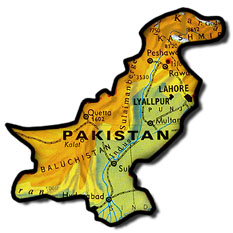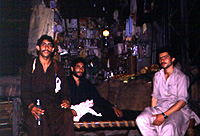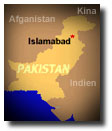| Pakistan  Since its rise in 1947
Pakistan has been hit hard by inner and outer
opposition. These culminated during their civil
war 1971, when East-Pakistan became Bangladesh.
Following these events the political disturbances
have contiued with coup d'etat followed by
purges. Pakistans economical situation is
difficult - the areas around Punjab have almost
completely been destroyed due to intensive
irrigation. Since its rise in 1947
Pakistan has been hit hard by inner and outer
opposition. These culminated during their civil
war 1971, when East-Pakistan became Bangladesh.
Following these events the political disturbances
have contiued with coup d'etat followed by
purges. Pakistans economical situation is
difficult - the areas around Punjab have almost
completely been destroyed due to intensive
irrigation.
|
 |
 Pakistan occupies
the westerly region of the Indien continent around the
river Indus. The main areaare the flatlands around the
river Indus with its fertile area in the north - the
agriculture area of Pujab ("land of five
rivers"). Otherwise the flatlands are basiclly very
dry, partially desert like, for ex. Sind in the south. In
the west one will find Beluchistan where there are
mountainous regions, and the northern region which is
occupied of the mountain range Karakoram. The climate is continental and
very dry. The bordering mountains towards Kashmir recieve
most precipitation. Pakistan occupies
the westerly region of the Indien continent around the
river Indus. The main areaare the flatlands around the
river Indus with its fertile area in the north - the
agriculture area of Pujab ("land of five
rivers"). Otherwise the flatlands are basiclly very
dry, partially desert like, for ex. Sind in the south. In
the west one will find Beluchistan where there are
mountainous regions, and the northern region which is
occupied of the mountain range Karakoram. The climate is continental and
very dry. The bordering mountains towards Kashmir recieve
most precipitation.
 The population increase in Pakistan
is enormous - amoungst the largest in Asia. The
largest portion of the population work with stock
and farming. Wheat, rice and corn are the major
vegetables grown using the irrigation systems.
The most important crops that are sold are
sugarcane and cotton. There are several power
plants in Pakistan, most along the Indus river
and its connecting rivers, although the industry
is poorly developed (most developed are cotton,
merchantile and steel industry, along with the
chemical industry). Mining for minerals is still
undeveloped. The population increase in Pakistan
is enormous - amoungst the largest in Asia. The
largest portion of the population work with stock
and farming. Wheat, rice and corn are the major
vegetables grown using the irrigation systems.
The most important crops that are sold are
sugarcane and cotton. There are several power
plants in Pakistan, most along the Indus river
and its connecting rivers, although the industry
is poorly developed (most developed are cotton,
merchantile and steel industry, along with the
chemical industry). Mining for minerals is still
undeveloped. |

Traders in Pakistan |
 |
 During the 900 century islam
penetrated its self into northwestern India, and
periodically the penninsula was dominated by
different islamic rulers. During Indias fight for
independance against Brittain the Muslimskaligan
was formed. 1947 saw an end of the colonial rule.
The islamic regions surrounding the great rivers
in the east and west formed Pakistan (the land
parts of East-Pakistan and West-Pakistan) under
the Ligans ruling of Jinnah. The penninsula it
self became the hinduien India. During the 900 century islam
penetrated its self into northwestern India, and
periodically the penninsula was dominated by
different islamic rulers. During Indias fight for
independance against Brittain the Muslimskaligan
was formed. 1947 saw an end of the colonial rule.
The islamic regions surrounding the great rivers
in the east and west formed Pakistan (the land
parts of East-Pakistan and West-Pakistan) under
the Ligans ruling of Jinnah. The penninsula it
self became the hinduien India. |
There after followed
persecutions of religious groups, war over the province
of Kashmir and refugees fleeing in both directions.
General Ayub Khan became ruler 1958. Ayub attempted to
ease the conflict between the the two parlements and to
start up an economical development. Besides his success
he was forced to step down 1969 due to his undemocratic
position and leadership. Yahya Khan succeeded Ayub and
held a general election. The elections were won by party
from East-Pakistan, this lead to a civil war and later a
splitting of the country 1971- which was strengthend with
support from India. East-Pakistan became Bangladesh. In
the former West-Pakistan, now Pakistan civil politician
Ali Bhutto ruled the country. Following a major landslide
election 1977 Bhutto was accused of cheating during the
elections and was over-thrown by a military coup which
was lead by general Zia ulHaq who later executed Bhutto.
Islamic law was installed by general Zia, by 1988 had
begun somewhat of a democratic system.
 1972 Pakistan left the Commonwealth
of Brittain. Support from foreign countries has been
sought partly China and the U.S.A. During the war against
Afganistan the US increased its relief to Pakistan - the
country was forced to accept 4 milljion Afgani refugees. 1972 Pakistan left the Commonwealth
of Brittain. Support from foreign countries has been
sought partly China and the U.S.A. During the war against
Afganistan the US increased its relief to Pakistan - the
country was forced to accept 4 milljion Afgani refugees.
 The Pakistan flag is green with a
half-moon and a star, the old symbol of islam.
The white flag was added to represent the
non-islamic minorities in the country. The Pakistan flag is green with a
half-moon and a star, the old symbol of islam.
The white flag was added to represent the
non-islamic minorities in the country. |
 |

 Pakistan - some facts: Pakistan - some facts:
- Area: 804000 sq. km
(twice the size of Sweden)
- Climate: Very warm
desert to arctic climate in the mountains in the
north.
- Population: apx. 131
million inhabitants (July 1995) Increase in
population: 1.28 %- 41.8 births /1000. Mortality:
12.07 /1000 inhabitants. Average life expectancy:
57.86 years.
- Capital: Islamabad
- Largest cities:
Karachi, Lahore
- Language: Urdu,
English
- Religion: Islam
(sunnitan) 97%, Christianity, Hindu
- Political status:
Republic
- Monetary: 1 rupie=
100 paisa
- Independance Day:
Pakistan Day, March 23 (Republic birth)
- Telephone system: 7
telephones / 1000 inhabitants.

Latest News  Log-book Log-book  Weather Weather  Maps Maps  Description Description  Procedure Procedure
Participants  Trekking Gruope Trekking Gruope  Himalaya Himalaya  Pakistan Pakistan  Hidden Peak Hidden Peak  Gallery Gallery
Equipement  Sponsors Sponsors  Links Links  Press Clippings Press Clippings  Other Other
 Contact Us Contact Us  Back home... Back home...

Web Design and
internet provider - Teknikhuset i UmeŚ, Sweden
© Copyright 1997 Svenska Hidden Peak Expeditionen 1997
All rights reserved
|



